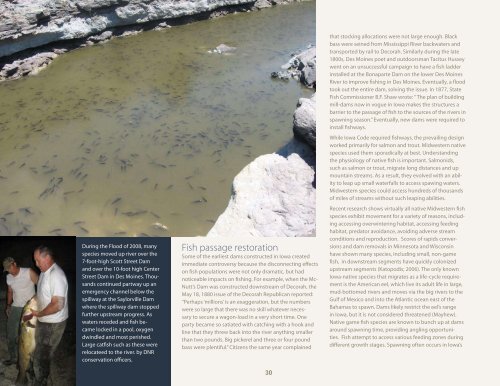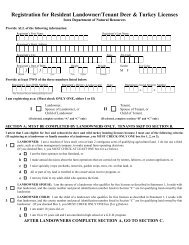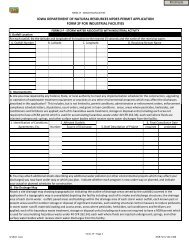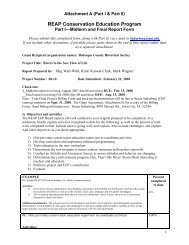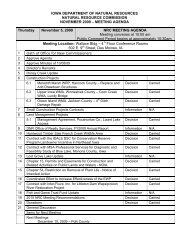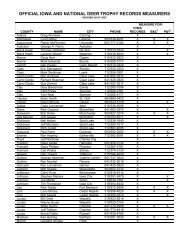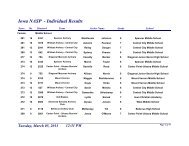3 Dams and River Ecology - Iowa Department of Natural Resources
3 Dams and River Ecology - Iowa Department of Natural Resources
3 Dams and River Ecology - Iowa Department of Natural Resources
You also want an ePaper? Increase the reach of your titles
YUMPU automatically turns print PDFs into web optimized ePapers that Google loves.
During the Flood <strong>of</strong> 2008, many<br />
species moved up river over the<br />
7-foot-high Scott Street Dam<br />
<strong>and</strong> over the 10-foot high Center<br />
Street Dam in Des Moines. Thous<strong>and</strong>s<br />
continued partway up an<br />
emergency channel below the<br />
spillway at the Saylorville Dam<br />
where the spillway dam stopped<br />
further upstream progress. As<br />
waters receded <strong>and</strong> fish became<br />
locked in a pool, oxygen<br />
dwindled <strong>and</strong> most perished.<br />
Large catfish such as these were<br />
relocateed to the river. by DNR<br />
conservation <strong>of</strong>ficers.<br />
Fish passage restoration<br />
Some <strong>of</strong> the earliest dams constructed in <strong>Iowa</strong> created<br />
immediate controversy because the disconnecting effects<br />
on fish populations were not only dramatic, but had<br />
noticeable impacts on fishing. For example, when the Mc-<br />
Nutt’s Dam was constructed downstream <strong>of</strong> Decorah, the<br />
May 18, 1880 issue <strong>of</strong> the Decorah Republican reported:<br />
“Perhaps ‘millions’ is an exaggeration, but the numbers<br />
were so large that there was no skill whatever necessary<br />
to secure a wagon-load in a very short time. One<br />
party became so satiated with catching with a hook <strong>and</strong><br />
line that they threw back into the river anything smaller<br />
than two pounds. Big pickerel <strong>and</strong> three or four pound<br />
bass were plentiful.” Citizens the same year complained<br />
30<br />
that stocking allocations were not large enough. Black<br />
bass were seined from Mississippi <strong>River</strong> backwaters <strong>and</strong><br />
transported by rail to Decorah. Similarly during the late<br />
1800s, Des Moines poet <strong>and</strong> outdoorsman Tacitus Hussey<br />
went on an unsuccessful campaign to have a fish ladder<br />
installed at the Bonaparte Dam on the lower Des Moines<br />
<strong>River</strong> to improve fishing in Des Moines. Eventually, a flood<br />
took out the entire dam, solving the issue. In 1877, State<br />
Fish Commissioner B.F. Shaw wrote: “ The plan <strong>of</strong> building<br />
mill-dams now in vogue in <strong>Iowa</strong> makes the structures a<br />
barrier to the passage <strong>of</strong> fish to the sources <strong>of</strong> the rivers in<br />
spawning season.” Eventually, new dams were required to<br />
install fishways.<br />
While <strong>Iowa</strong> Code required fishways, the prevailing design<br />
worked primarily for salmon <strong>and</strong> trout. Midwestern native<br />
species used them sporadically at best. Underst<strong>and</strong>ing<br />
the physiology <strong>of</strong> native fish is important. Salmonids,<br />
such as salmon or trout, migrate long distances <strong>and</strong> up<br />
mountain streams. As a result, they evolved with an ability<br />
to leap up small waterfalls to access spawing waters.<br />
Midwestern species could access hundreds <strong>of</strong> thous<strong>and</strong>s<br />
<strong>of</strong> miles <strong>of</strong> streams without such leaping abilities.<br />
Recent research shows virtually all native Midwestern fish<br />
species exhibit movement for a variety <strong>of</strong> reasons, including<br />
accessing overwintering habitat, accessing feeding<br />
habitat, predator avoidance, avoiding adverse stream<br />
conditions <strong>and</strong> reproduction. Scores <strong>of</strong> rapids conversions<br />
<strong>and</strong> dam removals in Minnesota <strong>and</strong> Wisconsin<br />
have shown many species, including small, non-game<br />
fish, in downstream segments have quickly colonized<br />
upstream segments (Katopodis; 2006). The only known<br />
<strong>Iowa</strong>-native species that migrates as a life-cycle requirement<br />
is the American eel, which live its adult life in large,<br />
mud-bottomed rivers <strong>and</strong> moves via the big rivers to the<br />
Gulf <strong>of</strong> Mexico <strong>and</strong> into the Atlantic ocean east <strong>of</strong> the<br />
Bahamas to spawn. <strong>Dams</strong> likely restrict the eel’s range<br />
in <strong>Iowa</strong>, but it is not considered threatened (Mayhew).<br />
Native game fish species are known to bunch up at dams<br />
around spawning time, providing angling opportunities.<br />
Fish attempt to access various feeding zones during<br />
different growth stages. Spawning <strong>of</strong>ten occurs in <strong>Iowa</strong>’s


